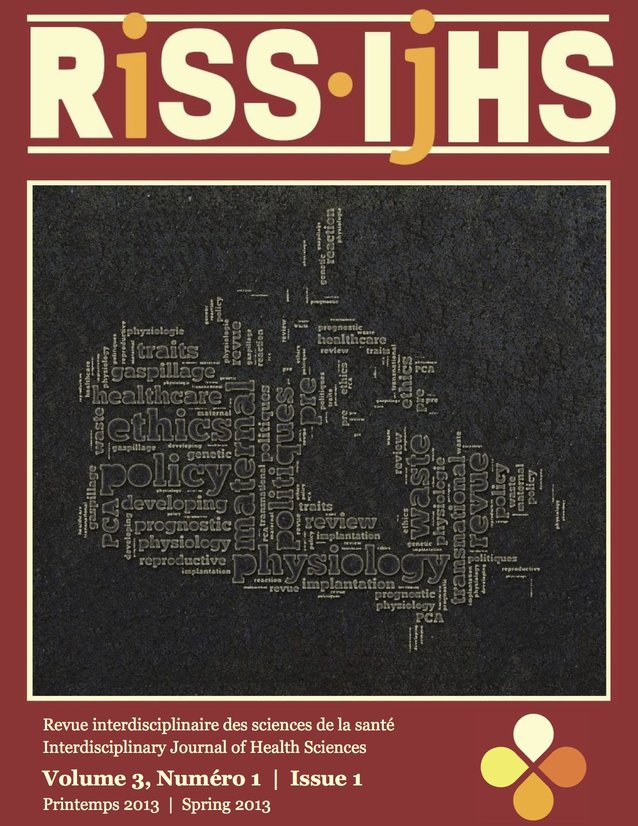Role of Estrogen Receptors in Male Reproductive Physiology
DOI :
https://doi.org/10.18192/riss-ijhs.v3i1.1452Mots-clés :
GPR30, GPER1, xeno-œstrogène, signalisation, reproduction mâleRésumé
Les récepteurs des œstrogènes canoniques (ER α/β) ont un mécanisme d’action génomique, fonctionnant comme des facteurs de transcription nucléaires pour les gènes œstrogéno-dépendantes. Les récepteurs œstrogéniques sont bien établis au sein de l’appareil reproducteur mâle où l’œstrogène joue un rôle essentiel au niveau de la fertilité masculine.
La caractérisation récente du nouveau récepteur œstrogénique couplé à une protéine G GPR30 (également connue sous GPER1), reposant sur la capacité des voies de signalisation intracellulaires non génomiques de transduire des signaux œstrogéniques, nécessite un réexamen du rôle des récepteurs des œstrogènes au niveau de la reproduction masculine. En outre, l’affinité des œstrogènes environnementaux (xéno-œstrogènes) pour les sous-types de récepteurs œstrogéniques pourra fournir de renseignements supplémentaires concernant les effets reproductifs de ces produits chimiques sur la fertilité des hommes.
Nous examinons ici la structure et les fonctions de chaque récepteur œstrogène dans le cadre de la reproduction masculine, en portant une attention particulière aux conséquences reproductives de l’exposition aux xéno-œstrogènes.
Références
Chimento, A., Sirianni, R., Delalande, C., Silandre, D., Bois, C., Andò, S., ... Pezzi, V. (2010). 17 [beta]-estradiol activates rapid signaling pathways involved in rat pachytene spermatocytes apoptosis through GPR30 and ER (alpha). Molecular and Cellular Endocrinology, 320(1-2), 136-144. doi: 10.1016/j.mce.2010.01.035
Filardo, E. J., Quinn, J. A., Bland, K. I., & Frackelton Jr, A. R. (2000). Estrogen-induced activation of Erk-1 and Erk-2 requires the G protein-coupled receptor homolog, GPR30, and occurs via trans-activation of the epidermal growth
Funakoshi, T., Yanai, A., Shinoda, K., Kawano, M. M., & Mizukami, Y. (2006). G protein-coupled receptor 30 is an estrogen receptor in the plasma membrane. Biochemical and Biophysical Research Communications, 346(3), 904- 910. doi: 10.1016/j.bbrc.2006.05.191
Hess, R. A. (2003). Estrogen in the adult male reproductive tract: A review. Reproductive Biology and Endocrinology, 1(1), 52-66.
Hess, R. A., Bunick, D., Lee, K. H., Bahr, J., Taylor, J. A., Korach, K. S., & Lubahn, D.B. (1997). A role for oestrogens in the male reproductive system. Nature, 6659, 509-511. doi: 10.1038/37352
Howdeshell, K. L., Peterman, P. H., Judy, B. M., Taylor, J. A., Orazio, C. E., Ruhlen, R. L... Welshons, W.V. (2003). Bisphenol A is released from used polycarbonate animal cages into water at room temperature. Environmental Health Perspectives, 111(9), 1180. Retrieved from http:// www.ncbi.nlm.nih.gov/pmc/articles/PMC1241572/
Kelly, M. J., & Wagner, E. J. (1999). Estrogen modulation of G-protein-coupled receptors. Trends in Endocrinology and Metabolism, 10(9), 369-374.
Kuiper, G. G. J. M., Carlsson, B., Grandien, K., Enmark, E., Häggblad, J., Nilsson, S., & Gustafsson, J.A. (1997). Comparison of the ligand binding specificity and transcript tissue distribution of estrogen receptors α and β. Endocrinology, 138(3), 863-870. doi: http://dx.doi.org/10.1210/ endo.138.3.4979#sthash.ybf8R6NW.dpuf
Lannigan, D. A. (2003). Estrogen receptor phosphorylation. Steroids, 68(1), 1-9. doi: 10.1016/S0039-128X(02) 00110-1
Lucas, T. F. G., Royer, C., Siu, E. R., Lazari, M. F. M., & Porto, C. S. (2010). Expression and signaling of G protein-coupled estrogen receptor 1 (GPER) in rat sertoli cells. Biology of Reproduction, 83(2), 307-317. doi: 10.1095/biolreprod.110.084160
O’Donnell, L., Robertson, K. M., Jones, M. E., & Simpson, E. R. (2001). Estrogen and spermatogenesis. Endocrine Reviews, 22(3), 289-318. Retrieved from http:// dx.doi.org/10.1210/edrv.22.3.0431
Olde, B., & Leeb-Lundberg, L. (2009). GPR30/GPER1: Searching for a role in estrogen physiology. Trends in Endocrinology & Metabolism, 20(8), 409-416. doi: 10.1016/ j.tem.2009.04.006
Otto, C., Fuchs, I., Kauselmann, G., Kern, H., Zevnik, B., Andreasen, P., et al. (2009). GPR30 does not mediate estrogenic responses in reproductive organs in mice. Biology of Reproduction, 80(1), 34-41. doi: 10.1095/ biolreprod.108.071175
Otto, C., Rohde-Schulz, B., Schwarz, G., Fuchs, I., Klewer, M., Brittain, D., et al. (2008). G protein-coupled receptor 30 localizes to the endoplasmic reticulum and is not activated by estradiol. Endocrinology, 149(10), 4846-4856. doi: 10.1210/en.2008-0269
Prossnitz, E. R., Arterburn, J. B., Smith, H. O., Oprea, T. I., Sklar, L. A., & Hathaway, H. J. (2008). Estrogen signaling through the transmembrane G protein-coupled receptor GPR30. Annual Review of Physiology, 70, 165-190. doi: 10.1146/annurev.physiol.70.113006.100518
Prossnitz, E. R., & Maggiolini, M. (2009). Mechanisms of estrogen signaling and gene expression via GPR30. Molecular and Cellular Endocrinology, 308(1), 32-38. doi: 10.1016/j.mce.2009.03.026
Razandi, M., Pedram, A., Greene, G. L., & Levin, E. R. (1999). Cell membrane and nuclear estrogen receptors (ERs) originate from a single transcript: Studies of ERα and Erβ expressed in Chinese hamster ovary
cells. Molecular Endocrinology, 13(2), 307-319.
Shughrue, P. J., & Merchenthaler, I. (2000). Estrogen is more than just a “sex hormone”: Novel sites for estrogen action in the hippocampus and cerebral cortex. Frontiers in Neuroendocrinology, 21(1), 95-101. doi: 10.1006/ frne.1999.0190
Simoncini, T., & Genazzani, A. R. (2003). Non-genomic actions of sex steroid hormones. European Journal of Endocrinology, 148(3), 281-292. doi: 10.1530/eje.0.1480281
Swedenborg, E., Rüegg, J., Mäkelä, S., & Pongratz, I. (2009). Endocrine disruptive chemicals: Mechanisms of action and involvement in metabolic disorders. Journal of Molecular Endocrinology, 43(1), 1-10. doi: 10.1677/JME- 08-0132
Thomas, P., & Dong, J. (2006). Binding and activation of the seven-transmembrane estrogen receptor GPR30 by environmental estrogens: A potential novel mechanism of endocrine disruption. The Journal of Steroid Biochemistry and Molecular Biology, 102(1-5), 175-179. doi: 10.1016/ j.jsbmb.2006.09.017
Téléchargements
Publié-e
Numéro
Rubrique
Licence
- Tous les auteurs dont l’article est publié dans la RISS en conserveront les droits.
- Les auteurs accordent à la RISS le droit d’être la première à publier les articles qui lui sont soumis.
- Tous les articles publiés dans la RISS sont autorisés en vertu d’une licence Creative Commons Attribution à être circulé si les auteurs et la revue de la publication originale sont reconnus.
- La RISS est publiée en ligne et imprimée. La RISS n’est pas responsable de l’utilisation non autorisée du contenu publié sous forme électronique ou imprimée.
- La RISS retient les droits de distribution de tout le contenu.
- Les auteurs, et non la RISS, sont responsables d’avoir obtenu les permissions nécessaires concernant les travaux cités.


